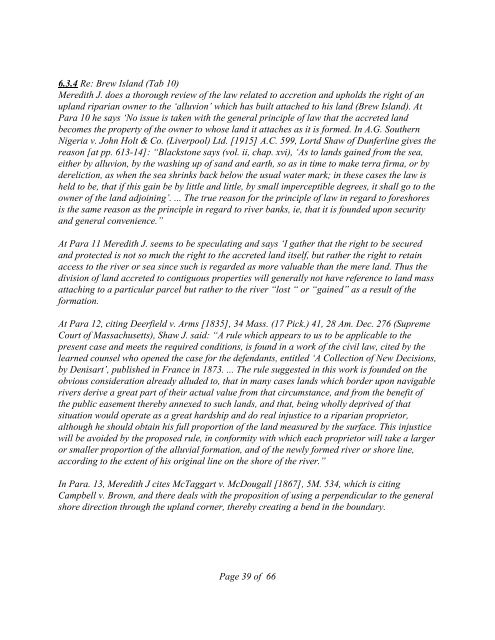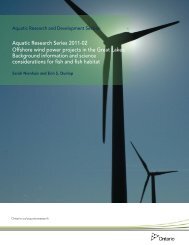Report of Research, Field Investigation and Survey of Robert D ...
Report of Research, Field Investigation and Survey of Robert D ...
Report of Research, Field Investigation and Survey of Robert D ...
Create successful ePaper yourself
Turn your PDF publications into a flip-book with our unique Google optimized e-Paper software.
6.3.4 Re: Brew Isl<strong>and</strong> (Tab 10)<br />
Meredith J. does a thorough review <strong>of</strong> the law related to accretion <strong>and</strong> upholds the right <strong>of</strong> an<br />
upl<strong>and</strong> riparian owner to the ‘alluvion’ which has built attached to his l<strong>and</strong> (Brew Isl<strong>and</strong>). At<br />
Para 10 he says ‘No issue is taken with the general principle <strong>of</strong> law that the accreted l<strong>and</strong><br />
becomes the property <strong>of</strong> the owner to whose l<strong>and</strong> it attaches as it is formed. In A.G. Southern<br />
Nigeria v. John Holt & Co. (Liverpool) Ltd. [1915] A.C. 599, Lortd Shaw <strong>of</strong> Dunferline gives the<br />
reason [at pp. 613-14]: “Blackstone says (vol. ii, chap. xvi), ‘As to l<strong>and</strong>s gained from the sea,<br />
either by alluvion, by the washing up <strong>of</strong> s<strong>and</strong> <strong>and</strong> earth, so as in time to make terra firma, or by<br />
dereliction, as when the sea shrinks back below the usual water mark; in these cases the law is<br />
held to be, that if this gain be by little <strong>and</strong> little, by small imperceptible degrees, it shall go to the<br />
owner <strong>of</strong> the l<strong>and</strong> adjoining’. ... The true reason for the principle <strong>of</strong> law in regard to foreshores<br />
is the same reason as the principle in regard to river banks, ie, that it is founded upon security<br />
<strong>and</strong> general convenience.”<br />
At Para 11 Meredith J. seems to be speculating <strong>and</strong> says ‘I gather that the right to be secured<br />
<strong>and</strong> protected is not so much the right to the accreted l<strong>and</strong> itself, but rather the right to retain<br />
access to the river or sea since such is regarded as more valuable than the mere l<strong>and</strong>. Thus the<br />
division <strong>of</strong> l<strong>and</strong> accreted to contiguous properties will generally not have reference to l<strong>and</strong> mass<br />
attaching to a particular parcel but rather to the river “lost “ or “gained” as a result <strong>of</strong> the<br />
formation.<br />
At Para 12, citing Deerfield v. Arms [1835], 34 Mass. (17 Pick.) 41, 28 Am. Dec. 276 (Supreme<br />
Court <strong>of</strong> Massachusetts), Shaw J. said: “A rule which appears to us to be applicable to the<br />
present case <strong>and</strong> meets the required conditions, is found in a work <strong>of</strong> the civil law, cited by the<br />
learned counsel who opened the case for the defendants, entitled ‘A Collection <strong>of</strong> New Decisions,<br />
by Denisart’, published in France in 1873. ... The rule suggested in this work is founded on the<br />
obvious consideration already alluded to, that in many cases l<strong>and</strong>s which border upon navigable<br />
rivers derive a great part <strong>of</strong> their actual value from that circumstance, <strong>and</strong> from the benefit <strong>of</strong><br />
the public easement thereby annexed to such l<strong>and</strong>s, <strong>and</strong> that, being wholly deprived <strong>of</strong> that<br />
situation would operate as a great hardship <strong>and</strong> do real injustice to a riparian proprietor,<br />
although he should obtain his full proportion <strong>of</strong> the l<strong>and</strong> measured by the surface. This injustice<br />
will be avoided by the proposed rule, in conformity with which each proprietor will take a larger<br />
or smaller proportion <strong>of</strong> the alluvial formation, <strong>and</strong> <strong>of</strong> the newly formed river or shore line,<br />
according to the extent <strong>of</strong> his original line on the shore <strong>of</strong> the river.”<br />
In Para. 13, Meredith J cites McTaggart v. McDougall [1867], 5M. 534, which is citing<br />
Campbell v. Brown, <strong>and</strong> there deals with the proposition <strong>of</strong> using a perpendicular to the general<br />
shore direction through the upl<strong>and</strong> corner, thereby creating a bend in the boundary.<br />
Page 39 <strong>of</strong> 66
















